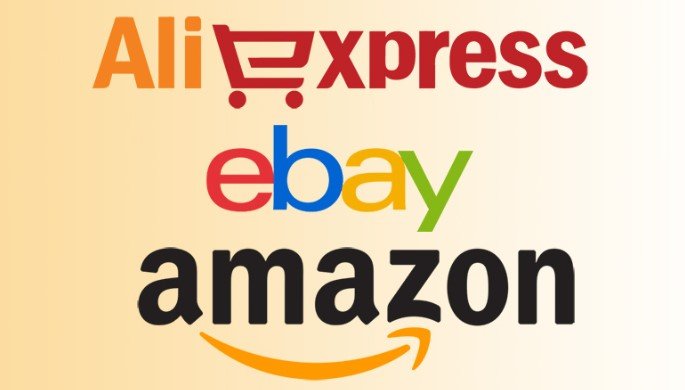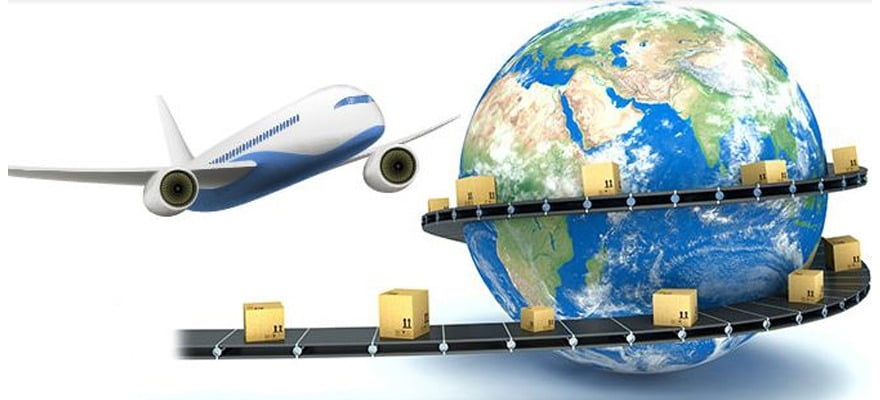
E-Commerce Players Amazon | eBay | Aliexpress Introduction
E-commerce has become a part of our daily lives. Most of us use it regularly for shopping for different types of products. They offer amazing discounts and the convenience of getting the products delivered at your doorstep. Amazon, AliExpress, and eBay are some of the largest and most prominent e-commerce players. The current article provides detailed insights into how these e-commerce platforms fare on different parameters:

Origin: How the E-Commerce Giants Started
Amazon is a U.S. based online shopping platform. It is owned by Jeff Bezos and is one of the most popular online shopping platforms. It is also the world’s largest e-commerce player with a market capitalization of more than $800 billion. It provides a platform for a large number of sellers to sell their products online. Amazon is a customer-friendly e-commerce platform that aims at providing the lowest cost to the buyers. Amazon shopping deals here

AliExpress is a part of the Chinese e-commerce giant-Alibaba. It was founded by Jack Ma. It provides a platform for selling consumer products globally. AliExpress though based out of China has been shifting its focus to the western consumes. It has been expanding the range of products available on it over time. You get competitive pricing for products while shopping on AliExpress. Aliexpress Shopping Deals & Discounts here
eBay is another popular e-commerce platform. It is based out of the U.S. It was originally known as Auction Web and later the name was changed to eBay. eBay sells a wide variety of products. You can also get second-hand products on it. You can also find some products which are old and difficult to find on eBay. It is an old and trusted e-commerce platform globally. eBay Discount Shopping Deals here
Business Model: Uniqueness of Each Platform
Amazon is in the business of stocking products that they sell. They have their own warehouses and stock some of the products that they directly sell to the customers. Amazon also allows retailers to sell their products on its platform to the buyers. It has its own supply chain to ensure the smooth and timely delivery of products to the buyers. This approach of owning its own inventory and supply chain makes Amazon different from AliExpress and eBay.

AliExpress and eBay have a different business model from Amazon. AliExpress works on an asset-light model and merely facilitates the transaction between the buyers and sellers. It does not stock or sells products on its own. It charges a small commission from the sellers for selling their products on their platform. Alibaba makes most of its revenues from its Taobao division which accounts for more than 80% of its total revenues. Taobao marketplace accounts for more than 80% of total online purchases in China.
eBay also adopts a similar business model to AliExpress. It does not stock the products it sells. They only act as an intermediary between the buyers and sellers. The e-commerce platform charges a commission from the seller who sells on its platform.
Business Approach and Philosophy
Each of these top e-commerce platforms has its unique business approach and philosophy. Amazon aims to become the world’s most customer-centric company. They put the customer at the core of their business philosophy. The company is driven by the customer’s preferences and constantly works towards providing excellent customer experience. Their business philosophy is backed by their achievements. They are obsessed with providing the best possible price to the buyers. Amazon has made impressive progress in terms of pricing, delivery, and customer support. Buyers can be assured that they are getting the best quality products at the lowest price on Amazon. They are known to squeeze the sellers for providing the lowest price to the customers.

AliExpress has a different business proposition. They aim at making small businesses in China grow by providing them access to global customers. AliExpress is known to be very friendly to small Chinese businesses.
eBay also provides sellers to use their platform for reaching out to a global market. They aim to create a customer-friendly shopping experience. eBay supports payment through PayPal which provides better security to buyers. You can skip sharing your credit card details online and pay using PayPal instead.
Geographic Focus: Local or Global E-Commerce Giants
There is a stark contrast on the geographic focus between these e-commerce giants. Amazon is U.S. based and offers most of its products in the U.S. market. Amazon sells to the global market and its business is not merely based in its home U.S. market. In fact, more than 40% of its total revenues come from the non-U.S. market. This reflects the globally diversified nature of Amazon’s business. However, experts feel Amazon needs to be careful due to the entry of AliExpress in the U.S. market.

AliExpress which is part of Alibaba is concentrated in China. Almost all its sellers are Chinese as it aims to promote Chinese businesses and allow them to grow. Nearly 84% of the total sales of Alibaba come from China. It has complete domination in the Chinese e-commerce market as it accounts for more than 80% of the total online sales in the country. Amazon does not enjoy this kind of stranglehold in their home U.S. market. This explains the stronghold that AliExpress has in its home market.
eBay has a global presence and market. It is based out of the U.S. but sells its products globally. Their revenues are also diversified and not concentrated in any particular region.
Customer Service and Buyer Protection: Are These E-Commerce Platforms Reliable?
Customer service and buyer protection are important aspects of any e-commerce platform. The buyers need to be sure that they are buying quality products and their rights would be protected. Amazon has good buyer protection systems in place. They have excellent replacement/refund processes that are hassle-free. You don’t have to worry about getting stuck with the wrong or a sub-standard product if you buy from Amazon.

AliExpress has a notorious reputation when it comes to customer service and buyer protection. It is generally much tougher to get a replacement/refund of products compared to Amazon.
eBay is also very customer-friendly. You can obtain replacement/refunds very easily on it. eBay is known to rule in favor of the buyers even if the seller is not at fault.
Number of Active Buyers: Outreach of E-Commerce Players
When it comes to the number of active buyers, Amazon has a clear edge over competitors. It is the largest online retailer and has surpassed Walmart. It has 304 million active buyers in 2018. Amazon Prime which is a subsidiary of Amazon had 80 million active buyers. The buyers are spread across the globe and not concentrated in a particular country and region.

Alibaba which is the parent company of AliExpress had 552 million active buyers in 2018. It has more active buyers than Amazon and eBay. Most of the users of Alibaba are based in China. While they are expanding and reaching out to a more global audience, the Chinese market remains the stronghold of Alibaba and AliExpress. It earns more than 80% of its total revenue from the Chinese market.
eBay had 175 million active buyers in 2018. It has a more global and diversified buyer profile compared to AliExpress.
Gross Merchandise Value: E-Commerce Sales
Gross Merchandise Value (GMV) is a measure of the total volume on an e-commerce platform. It is defined as the total value of the confirmed orders or closed the transaction on an e-commerce platform. In simple terms, GMV represents the total value of goods sold on the platform. Amazon had a GMV of more than $239 billion in 2017. This constituted of its B2B and B2C sales. Of this, $116 billion worth of GMV was sold directly by Amazon and the remaining $123 billion through third-party sellers.

Alibaba had the highest GMV among all at $768 billion. Taobao was the largest contributor with a GMV of $428 billion while Tmall accounted for $340 billion. Alibaba has been adding more incremental GMV year-on-year compared to its competitors Amazon and eBay. Alibaba is a behemoth in the e-commerce industry.
eBay had a GMV of $93 billion in 2017. In the year 2015, 41% of the total GMV clocked by eBay came from the U.S. market and the remaining 59% from the international market.
Number of Employees
The size and outreach of an e-commerce platform can be assessed by the number of employees it has. Amazon has the largest number of employees among these e-commerce players. It has more than 613,000 employees globally. The greater number of employees can be attributed to the fact that Amazon is a global and well-diversified e-commerce platform. It has offices and facilities in most countries. It also maintains its own warehouses and hires staff for it which is not done by AliExpress and eBay.

Alibaba has nearly 66,000 employees. The majority of its staff are located in China as a large part of their business comes from the country. It has been hiring employees for bolstering its global outreach and tapping the customers from international markets.
eBay has the least number of employees compared to Amazon and AliExpress. It has slightly more than 14,000 employees.
Financial Details: Which E-Commerce Player Has the Financial Might
Revenue generated is another indicator for evaluating the performance and success of e-commerce platforms. The greater the revenue, the more successful an e-commerce platform is in reaching out to customers and selling to them. In the year 2018, Amazon generated a revenue of $233 billion. Amazon has been able to collect more in the form of fees and commissions than other e-commerce competitors.

The total revenue generated by Alibaba in 2018 was more than $250 billion. It has been giving stiff competition to Amazon. Alibaba sells more goods than Amazon while the latter earns more in fees and commissions. However, when it comes to profitability, Alibaba beats Amazon by some margin. In the year 2013, Alibaba made nearly 10-times more profit than Amazon. This is due to the fact that Amazon has overhead expenses for maintaining its own warehouses and stocks. Alibaba and eBay on the other hand, only act as intermediaries between buyers and online sellers. Both Amazon and Alibaba are close when it comes to free cash flows. They generated nearly $5 billion worth of free cash flows in 2013.
eBay has been left behind in the race between Amazon and Alibaba. It could generate a revenue of only $10.746 billion in 2018.
Business Opportunities and Future Prospects of E-Commerce Players
Each of these e-commerce platforms provides unique business opportunities. They have their own strengths and dominant markets which work for them. Amazon provides you an opportunity to advertise with them and become their business partner. You can also submit your business proposal to them which they will help you to establish. It does not share data with third-party sellers. This helps Amazon to generate more revenue and compete with their partners.

Alibaba on the other hand, shares data with brands with a view of empowering them. It does not see its partners as competitors and allows data sharing to enable the sellers to succeed. You can also sell their products on your website through the affiliate program. With better performance, they may also increase your commission. Alibaba has been keen on expanding its global footprint. They have plans to invest in the U.S. for tapping the local market.
eBay also provides interesting business opportunities. They allow you to start your business enterprise on their website. eBay helps you to establish your business setup. You can choose the e-commerce platform which provides the best incentives for your business.
Conclusion
The e-commerce industry is highly competitive. Amazon and Alibaba (parent company of AliExpress) are the two most dominant industry players. There are various parameters to assess the performance of these e-commerce giants. On most fronts, Amazon and Alibaba steer ahead of the competition. Amazon is a more global and diversified platform with nearly 59% of its total sales coming from international markets. It stocks its own inventory and competes with the third-party sellers on their website.
AliExpress and eBay work like intermediaries between the buyers and sellers. They don’t maintain any products or warehouses of their own and only link the buyers and sellers. They charge a nominal fee to the sellers for selling products on their platform. With the growing competition between these e-commerce players, the customer is the real beneficiary and gets the maximum benefits.
Looking for discounts from 3 big eCommerce players?
